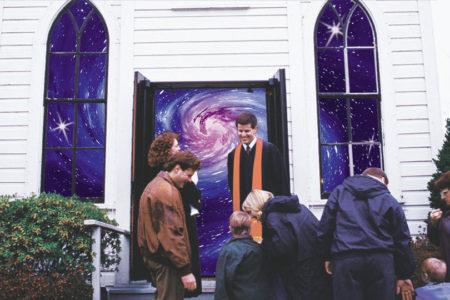How Near the End?
If there is one question that seems to come up more than any other these days, it is this one: “Do you believe that the coming of the Lord is really near?” For almost 2,000 years believers have been looking forward to that blessed day when the trump of God will sound, the archangel will shout, and the Lord Jesus Christ will come to claim His own. Now, as the world prepares to usher in yet another millennium, it is inevitable that Christians would ask, “How much longer, Lord?”
Many are searching the horizon for signs that His return is near. However, despite the presence of global conditions indicating that we are entering the era of the last days, the Bible teaches that we cannot know the precise time of His coming.
Someone recently gave me a book about prophecy that is organized around twenty-five “signs” supposedly evident in Israel today. Although the authors (one of whom is not a believer) never clearly state what these “signs” are signs of, they imply that a great eschatological drama is about to unfold. Some of their “signs,” however, are very questionable. One, for example, is “increasing rainfall.” Yet any Israeli can attest to the hardship that has been generated in the Holy Land by recent, consecutive years of drought. To claim rainfall as a “sign” is obviously not credible.
On the other hand, some of the events the authors mention are legitimately exciting, such as the possibility of a Middle East peace treaty and preparations to restore Temple worship. Despite even these “signs,” however, it is simply impossible to state conclusively that the coming of the Lord is near. The only sign that Jesus gave concerning His coming was the Abomination of Desolation mentioned by Daniel the prophet (Mt. 24:3–15). Those people who will be alive during the 70th week of Daniel chapter 9 will see the Abomination of Desolation. This biblical sign will herald the Great Tribulation, followed by other cosmic signs (24:29); and then the great sign of the Lord’s coming will take place (24:30).
Many of the evidences that prognosticators cite as end-time “signs” today are not what the New Testament indicates as such. Rather than being rooted in Scripture, most are based on speculation and misinformation and are not biblically documentable. Jesus and later writers of the New Testament frequently warned that we cannot know the time of His coming. Matthew 24:36 says, “But of that day and hour knoweth no man, no, not the angels of heaven, but my Father only.” The Rapture, or the “catching away” of the church (1 Thes. 4:16–17), will precede the Second Coming. If the Rapture is imminent (and Scripture certainly implies that it is), then it will occur suddenly, without warning—without signs. Consequently, many people are wrongly applying Scripture to prove the visibility of signs for something that has no signs. Signs will precede the Second Coming in glory. Matthew chapters 24 and 25 make that clear. But they will appear only to the generation living in Daniel’s 70th week. We are living in the Church Age and are looking for His appearance and our “catching away.” No signs for that event are evident today, in the biblical sense of the term.
However, some fascinating trends have obviously emerged in Israel and in the world-at-large that appear to be producing a climate more closely resembling end-time conditions than ever before. And believers in the prophetic Word are taking note. While these trends certainly do not prove the “end is near,” they do indicate that it is nearer than ever before.
The Political Trend
This trend is manifested most obviously by the one-world emphasis that is so increasingly evident in the rhetoric and plans of international leaders. Talk of a “united nations,” a “global community,” and expressions such as “the world is a village” indicate that the world-at-large hopes a one-world government will emerge from the chaos of nations that has marked world history thus far. Even though many nations still stand apart from the “world community,” the fact that UN and NATO armies have united to attack these individual countries indicates that the world is coming together in a greater way than ever before. The Internet and other means of global communication have “shrunk” our planet in many ways. A famous song from the ‘60s era asks us to imagine a world without boundaries or armies and marked by the “brotherhood of man.” If some leaders had their way today, every nation on earth would relinquish its political sovereignty, and there would be no need to “imagine” it any longer.
Such “one-worldism” is exactly what Revelation chapters 13 and 17 describe as taking place under the political world ruler known as the Beast, or the Antichrist. Against the Old Testament prophetic background of Daniel chapters 2 and 7, a scenario will emerge of all nations under the sovereignty of a world leader who will bend obedience to himself through craft, deceit, and force. Many people are tired of patriotism and wars; they desire someone who will “bring us together.” How ignorant they are, however, of the consequences. A one-world government under the domination of a powerful world leader will mean compulsory economic controls and persecution of all who resist (Rev. 13:16–17). The only lasting and just one-world government will be the one ruled by the King of Kings and Lord of Lords. To say that the United Nations organization is a sign that Christ’s one-world government is near would be speculation, but it is a trend to mark and watch closely.
The Religious Trend
For many years ecumenical types have dreamed of a world church that would replace the many and various religious denominations. The organization known as the World Council of Churches has been one manifestation of this desire. The movement thus far, however, has been frustrated by those “stubborn” Bible believers who tenaciously maintain that unity must be based on truth, not on organizational membership. In recent years unity-at-all-cost movements, which water down valid belief distinctives, have emerged under the “evangelical” umbrella. Perhaps the cement that has eluded the ecumenicists will soon be provided by naïve evangelicals who lack the discernment so desperately needed to keep from being deceived today.
The problem of uniting professing Christians in a one-world church has been compounded by the large presence of non-Christian religions in the world. How can they be brought under the same umbrella? An alarming component in this religious trend may provide the answer—the New Age Movement. Much has been said about the New Age Movement. It bears more earmarks of Eastern religions than anything else, and it totally blurs the edges of truth, dissolving everything into a murky uniting with the “One,” whatever that nondefined “uniting” may be. The theme of this movement is again expressed in the wish, that “the world will be as one.”
Perhaps this “new age”—which some have called the “old lie” of the Garden (Gen. 3)—will ultimately provide the glue that will bind the various religions into a one-world religious movement. Scripture indicates that someday the unsaved inhabitants of this earth will unite in worshiping the Beast at the behest of his religious prime minister, the False Prophet (Rev. 13). Although no one can state definitively that the ecumenical movement is a sign in the biblical sense of the term, it is a trend to mark and watch closely.
The Moral Trend
The following Pauline texts are particularly relevant here.
Now the Spirit speaketh expressly that, in the latter times, some shall depart from the faith, giving heed to seducing spirits, and doctrines of demons, Speaking lies in hypocrisy, having their conscience seared with a hot iron, Forbidding to marry, and commanding to abstain from foods, which God hath created to be received with thanksgiving by them who believe and know the truth (1 Tim. 4:1–3).
This know, also, that in the last days perilous times shall come. For men shall be lovers of their own selves, covetous, boasters, proud, blasphemers, disobedient to parents, unthankful, unholy, Without natural affection, trucebreakers, false accusers, incontinent, fierce, despisers of those that are good, Traitors, heady, high-minded, lovers of pleasures more than lovers of God, Having a form of godliness, but denying the power of it (2 Tim. 3:1–5).
The tremendous number of manifestations of this type of behavior actually makes it unnecessary to list them. Most people acquainted with the last 2,000 years of church history may tend to minimize this last point, knowing that such characteristics have always been evident, to a lesser or greater degree, in the church and in the world. The criticism has some validity. Yet it is still worth noting that never before have all three trends been as prevalent during the very same period as they are today. While increasing immorality may not be a dogmatic indication of anything in itself, in combination with the world’s progress toward a one-world political organization and a one-world religious system, it provides a scenario to mark and watch closely.
Is the coming of the Lord really near? It may be a very short time until the “end,” or it may (which seems rather unlikely) be a very long time. No one knows. We do not know more than the angels or the Lord Himself in His humanity. Consequently, believers must be diligent to refrain from unsupported speculation, which has an uncanny way of crashing down upon our heads and discouraging the weaker brethren. It is far wiser to be awake and aware of the times and to be busy about the Lord’s work of world evangelism. (See Acts 1:6–8.) That is how His church can best fulfill His desire to “Occupy till I come” (Lk. 19:13).







